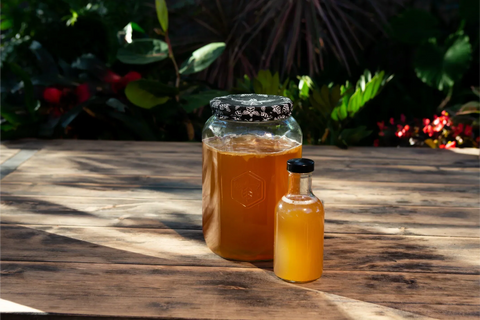TL;DR: Homebrewing Is Totally Doable in an Apartment
Wondering how to brew beer in an apartment? Curious if it’s even doable? Apartment homebrewing is easier than you might think. You don’t need much space at all to start small batch homebrewing. With a few clever strategies and the right tools, you can make great beer without a garage, backyard, or basement. Key tips:
-
Start with small batch homebrewing using 1-gallon or apartment-sized kits.
-
Brew on a stovetop instead of outdoors.
-
Choose low-odor beer styles like blonde ales or lagers.
-
Store fermenters in cabinets, closets, or small corners.
-
Keep it clean homebrewing with compact, no-rinse sanitizers.
Is Apartment Homebrewing Possible?
Absolutely. You don’t need a garage, backyard, or basement to make great beer. With the right tools and a few adjustments, you can ferment your first batch right next to your espresso machine.
Apartment brewing is ideal for:
-
First-time homebrewers
-
City dwellers
-
Students or renters
-
Anyone with limited square footage
Start with a 1-Gallon Kit (The Perfect Apartment Brewing Kit)
One of the easiest ways to practice brewing beer in small spaces is to use a 1-gallon apartment brewing kit. These small space homebrewing kits are designed specifically for small batch homebrewing, producing 8–10 bottles of beer per batch — enough to experiment without committing to a full 5-gallon batch and all the clunky equipment for larger volume brewing. If you have space to boil pasta, you have room to brew beer at home!
Benefits of a small apartment brewing kit include:
-
Compact fermenters that fit in closets, cabinets, or countertops
-
Stovetop-compatible recipes just need one pot & one burner
-
Simplified brewing steps, making it perfect for beginners
Craft a Brew’s beginner-friendly kits are designed for city apartments, tiny homes or even those living the #VanLife, combining all the ingredients you need in a compact, space-saving brewing equipment setup.
Brew on Your Kitchen Stove
You can start homebrewing without a garage - no need for a propane burner or a backyard either. Most apartment homebrewing setups work perfectly on a standard kitchen stove. A 2 gallon stock pot, a clean counter for prep, and a little ventilation is all you need.
Small space brewing essentials that you probably already own:
-
A 2 gallon stock pot with a lid (a standard size most folks own)
-
A large spoon or brew paddle
-
A fine mesh strainer for filtering sediment
-
A bag of ice for making an ice bath to chill the wort (unfermented beer)
-
A 1 gallon fermenter with an airlock (included in Craft a Brew’s Beer Brewing Kits)
Managing Brew Day Smells in Small Spaces
Brew day will always fill your kitchen with a little aroma — just like when you’re cooking or baking. If you’ve ever toured a brewery, you’ll recognize the scent: sweet, bready, and malty with a hint of floral or piney hops once the boil begins. These aromas are a normal part of the process and fade quickly after brewing.
To keep your apartment comfortable on brew day, crack a window or turn on your oven vent fan for better airflow. A box fan or small air purifier also helps disperse steam and hop aromas faster.
Some beer styles are naturally more aromatic during fermentation. If you’re brewing beer in small spaces or shared apartments, choose milder or quicker-fermenting styles like:
-
Low ABV or session beers
If you’re sensitive to smells or sharing walls with roommates, you may want to skip highly aromatic styles such as:
-
Kettle Sours
-
Belgian Ales
-
Dry-hopped IPAs
-
High ABV beers
Indoor Brewing Tips:
-
Resist the urge to cover your brew pot during the boil. This will trap unwanted compounds in your beer and can risk a vegetal off-flavor.
-
Fermentation doesn’t produce overpowering smells, and as long as you have decent ventilation, it won’t make your entire apartment smell like a brewery. Store your fermenter in a bedroom or closet — anywhere out of direct sunlight — to minimize any noticeable aromas for roommates or neighbors.
Storage & Fermentation Solutions
One gallon fermenters don’t need much space — just stable temperatures and minimal light exposure. For apartment homebrewing, store your fermenter:
-
On your kitchen counter
-
Inside a kitchen cabinet or pantry
-
A dark corner of a closet
-
Beneath a sink or bathroom vanity
-
Under a desk or console
-
In a temperature controlled wine-fridge (set to 65-75ºF)
Adding an adhesive thermometer helps you monitor conditions without taking up extra room. Proper storage is key for brewing beer in small spaces and ensures that your beer ferments cleanly.
Apartment Cleaning Hacks for Brewers
Homebrewing isn’t messy by default — but it can be if you’re not organized. Clean homebrewing is critical in small spaces. With apartment homebrewing, organization and sanitation make all the difference. Use a no-rinse beer kit sanitizer (included in Craft a Brew’s Beer Making Kits) to save time. Soak your equipment in a large bowl or pitcher if your sink is too small, and line your workspace with towels or trays to contain spills. Stackable bins and drawers make it easy to store clean gear safely.
Keeping your brewing space tidy not only protects your beer from contamination but also keeps your apartment livable while you experiment with small batch homebrewing.
Can I Bottle Beer in an Apartment?
Yes! Bottling beer in an apartment is totally doable — you just need a strategy to stay tidy and organized. When brewing beer in small spaces, managing clutter is key. Here’s how to keep bottling day efficient and frustration-free:
Simplify your setup:
-
Use flip-top bottles instead of traditional caps. You’ll skip the bulky capping tool and avoid one-time-use caps.
-
Fill your bottles in the sink or bathtub to catch drips and foam overflow.
-
Line your workspace with towels or baking sheets to prevent sticky spills.
Stay organized while bottling:
-
Pre-rinse and sanitize bottles in batches — using a dish rack makes it easy to dry and organize them.
-
Store bottles in small clusters or use milk crates and cardboard six-pack holders to avoid tipping accidents.
-
If you have roommates or pets, a large plastic bin works great for containing all bottles in one clean, transportable space.
Store efficiently while carbonating:
-
Store bottles upright to help yeast settle neatly at the bottom.
-
Place bottles in stacked boxes or milk crates to save floor space — two layers high is safe if the bottom layer is well-supported.
-
Keep them in a closet or under-bed storage where temperatures stay steady.
Indoor Brewing Tips:
-
Want to skip bottling altogether? Upgrade to a Mini Keg System and serve beer right from your fridge. One keg replaces about ten bottles, freeing up space and reducing cleanup — a major win for apartment brewers.
-
Save space by using 32 oz flip top bottles. You’ll only need 4 per gallon, which can take up less space in your fridge than multiple smaller bottles.
Bonus: What You Don’t Need
Apartment homebrewing doesn’t require heavy, space-hogging tools that large batch brewers need. Here’s what you can skip if you're brewing in a tight space:
-
Skip 5-gallon carboys — too heavy, bulky, and hard to clean
-
Forget outdoor propane burners — your stovetop works just fine
-
Complex chillers — a simple ice bath in your kitchen sink will get the job done
-
A kegerator — small batch homebrewing only requires a few bottles for carbonation
Final Thoughts
Brewing beer in small spaces is not only possible, it can be incredibly rewarding.
If you’ve got a kitchen, a stovetop, and a love for beer, you’ve got what it takes to start homebrewing — even in a 500 sq ft apartment.
Start small, keep it clean, and experiment with small batch homebrewing — the limited space doesn’t limit your creativity.
Ready to Brew Without the Square Footage?
Check out Craft a Brew’s apartment-friendly kits and see how fun homebrewing in small spaces can be:





